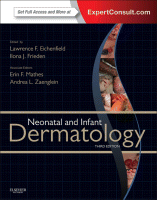Physical Address
304 North Cardinal St.
Dorchester Center, MA 02124

Introduction Nails are specialized cutaneous appendages composed of hard keratins similar to those found in hair, and are unique to primates. In humans, nails function as a stabilizing unit to aid in tactile sensation, grasping, and scratching. Well-manicured or adorned…

Introduction This chapter covers neonatal hair patterns, genetic hair shaft abnormalities, and the conditions in which hypo- or hypertrichosis are present in the neonatal period. There are many syndromes in which hypotrichosis or atrichia occur, and those in which it…

Introduction Examination of the mucous membranes is an important, yet often overlooked, part of the neonatal evaluation. This chapter discusses abnormal cutaneous findings of the oral, genital, and ocular systems. Many of these abnormalities provide important clues to the diagnosis…

Approach to the child with a genetic skin condition To effectively care for an affected newborn and provide information for anxious parents, an organized diagnostic approach is essential. The physical exam requires special attention to ectodermal involvement by assessing the…

Introduction Skin disorders characterized by infiltrative lesions can be present at birth or develop during the first few months of life. Some represent frank neoplasms, both benign and malignant, whereas others are the result of metabolic errors. In most instances,…

Introduction The subcutaneous fat cushions the overlying skin, insulates and provides energy storage, and protects underlying soft tissue and bony structures. Although not fully functional at birth, a well-developed fatty layer is present in the neonate, even when premature. Disorders…

Lumps and bumps A wide variety of conditions affecting the skin and subcutaneous tissues present as papulonodular lesions, or ‘lumps and bumps.’ Benign and malignant neoplasms, hamartomas, and inflammatory and infectious disorders, as well as a number of infiltrative diseases,…

Acneiform disorders Neonatal acne (neonatal cephalic pustulosis) Neonatal acne (acne neonatorum) is a very common newborn eruption, occurring in up to 20% of healthy babies. Lesions are not present at birth but typically appear within the first 2–3 weeks of…

Introduction Hyperpigmented lesions, presenting at birth and during the first few weeks of life, are quite common. Pigmented lesions can range from small and isolated to large and multiple. They can exist independently, or in association with other signs and…

Introduction A diverse group of conditions present with hypopigmentation in neonates and infants. A practical clinical approach would be to categorize them according to the distribution of the hypopigmentation: generalized, mosaic, or localized ( Box 23.1 ). Some may be…